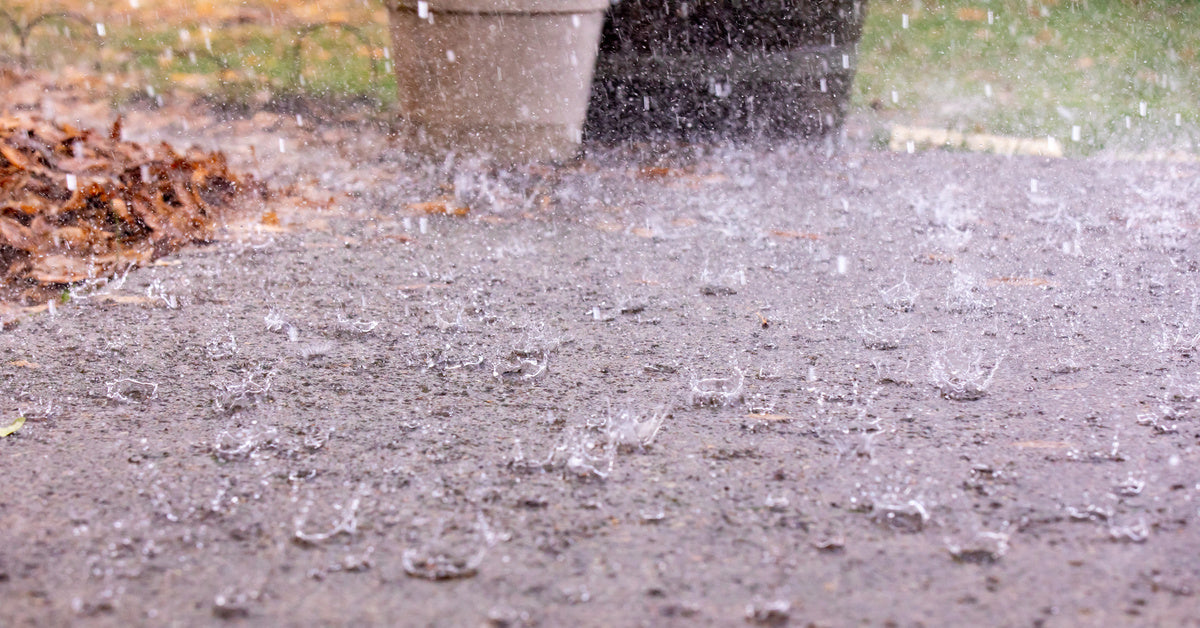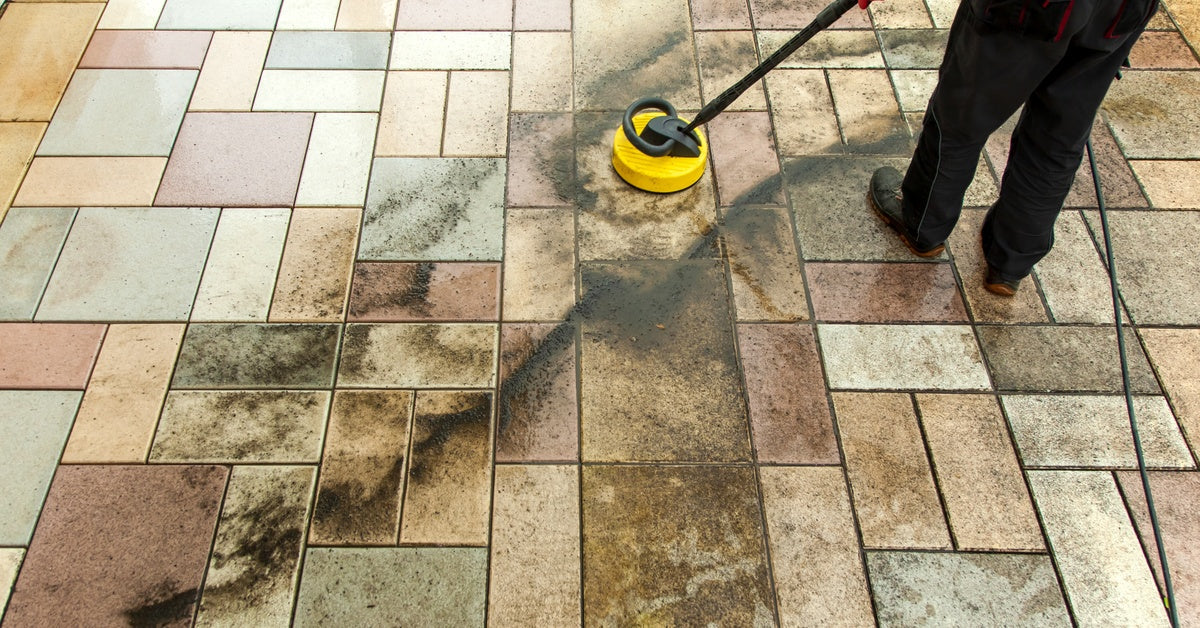Maintaining a pristine patio requires understanding the environmental factors that contribute to wear and tear. One of the most persistent issues homeowners face is the appearance of black spots on their patios and other surfaces, which can detract from the beauty of outdoor spaces. These spots are often a result of biological growth, which weather conditions can greatly influence.
This post will explain what patio black spots are and how different weather patterns contribute to their development. Understanding the relationship between weather and black spot growth is the first step toward effective prevention and removal to help you keep your patio looking its best.
What Are Patio Black Spots?
Patio black spots are a common form of discoloration found on outdoor surfaces like stone, concrete, and brick. These spots are not dirt or simple stains; they are living organisms. Specifically, they are a type of lichen, a composite organism arising from algae or cyanobacteria living among filaments of multiple fungi species in a mutualistic relationship.
The organism, often identified as Lichenothelia, thrives in porous, damp environments. It anchors itself deep within the pores of the patio material, making it difficult to remove with conventional cleaning methods. The black appearance is a defense mechanism, a dark pigment that protects the organism from ultraviolet (UV) radiation.
As the lichen grows, it forms a crust-like patch that is resilient and can spread over time if you do not treat it. Its root-like structures, known as hyphae, penetrate the stone, which is why scrubbing alone is often ineffective. This resilience is what makes black spot a persistent problem for many homeowners.
How Different Weather Conditions Influence Black Spots
Moisture Levels and Humidity
Moisture is the single most critical factor for the growth of black spots. Lichens, like other fungi and algae, require water to survive and reproduce. Patios that are frequently damp or located in areas with high humidity provide an ideal breeding ground for these organisms.
Rainfall is a primary source of moisture that encourages black spot development. After a rain shower, water can pool in low-lying areas of a patio or seep into the porous surfaces of the stone. This retained moisture creates the damp conditions necessary for lichen spores to germinate and establish themselves.
High humidity levels also contribute significantly to the problem. In humid climates, the air itself contains enough moisture to sustain lichen growth, even without direct rainfall. Morning dew is another common source of moisture that can keep patio surfaces damp for extended periods, further promoting the growth of black spots.

Temperature
Temperature plays a significant role in the life cycle of the black spot-causing lichen. These organisms are surprisingly resilient and can survive in a wide range of temperatures, but they have an optimal range for growth. Moderate temperatures are particularly conducive to their proliferation.
Mild, temperate climates often see the most aggressive black spot growth. This is why black spots can be a year-round problem in many regions.
Extreme temperatures can slow down the growth of lichen but will not necessarily kill it. During periods of intense heat and drought, the lichen may become dormant. Similarly, in freezing conditions, its metabolic activity will decrease significantly. However, once the temperature returns to a more favorable range, the organism will resume its growth.
Wind and Air Circulation
Air circulation is another environmental factor that can influence the presence of black spots on a patio. Good airflow helps evaporate moisture from surfaces, making the environment less hospitable for lichen. Patios in open, windy locations are less likely to suffer from severe black spot infestations.
Poor air circulation, on the other hand, can exacerbate the problem. Enclosed or sheltered patios protected from the wind tend to stay damp for longer after rain or morning dew. This lack of airflow traps moisture at the surface level, creating the perfect microclimate for black spots to thrive.
Obstructions like walls, fences, and dense shrubbery can all limit air circulation around a patio. By impeding the natural drying process, these features contribute to the persistent dampness that encourages lichen growth. Improving ventilation in these areas can be an effective preventative measure.
Sunlight and UV Exposure
Sunlight has a dual effect on the growth of black spots. While the lichen requires some light for photosynthesis (via its algal component), excessive direct sunlight can be detrimental. This is why black spots are often more prevalent in shaded or north-facing areas of a patio.
Shaded areas tend to retain moisture for longer periods because they don’t experience the drying effects of direct sunlight. This prolonged dampness creates a more stable and favorable environment for lichen to grow. Areas under trees, awnings, or near walls are particularly susceptible.
The black pigmentation of the lichen serves as a protective shield against UV radiation. This allows the organism to survive even in areas that receive some sunlight. However, the combination of intense sunlight and dry conditions is generally unfavorable for its growth, which is why sun-drenched, well-drained patios tend to have fewer issues with black spots.

Preventing and Managing Black Spot Growth
Regular Cleaning
Consistent cleaning is a fundamental step in preventing the establishment of black spots. By regularly removing surface debris like leaves, dirt, and organic matter, you eliminate the nutrients that can support lichen growth. A simple sweeping or rinsing can make a significant difference.
For general maintenance, washing the patio with a mild detergent and a stiff-bristled brush can dislodge newly formed biological growth before it takes hold. This practice is most effective when done periodically, especially during wetter seasons when the risk of growth is higher.
However, once black spots have become established, standard cleaning methods are often insufficient. The lichen’s deep-rooted structure requires a more targeted approach to eradicate it completely.
Browse Patio Black Spot Removal
When regular cleaning fails to remove stubborn black spots, it is time to consider specialty treatments from a black spot removal company. These products are specifically formulated to kill the lichen and remove the staining it leaves behind. It is important to choose a product designed for your specific patio material to avoid damage.
Patio Black Spot Removers contain active ingredients that penetrate the pores of the stone to kill the organism at its root. Applying these treatments according to the manufacturer’s instructions is crucial for both effectiveness and safety. This ensures that the lichen is fully eradicated, preventing a quick return.
After treatment, complete a thorough rinsing to wash away the dead organic matter and any residual chemicals. In many cases, the results are immediate and dramatic, restoring the patio to its original appearance.
Weather-Wise Patio Care
By understanding how weather conditions like moisture, temperature, sunlight, and wind affect the growth of patio black spots, you can take proactive steps to protect your outdoor space.
Regular cleaning and strategic maintenance can significantly reduce the likelihood of a black spot infestation. However, for established and stubborn growth, specialized removal products like Patio Black Spot Remover offer a solution. Being mindful of the weather and its impact will help you implement an effective care regimen.
Adopting a weather-wise approach to patio care ensures that your outdoor living area remains a clean, safe, and inviting space for years to come. This proactive stance is the key to winning the battle against black spots.



